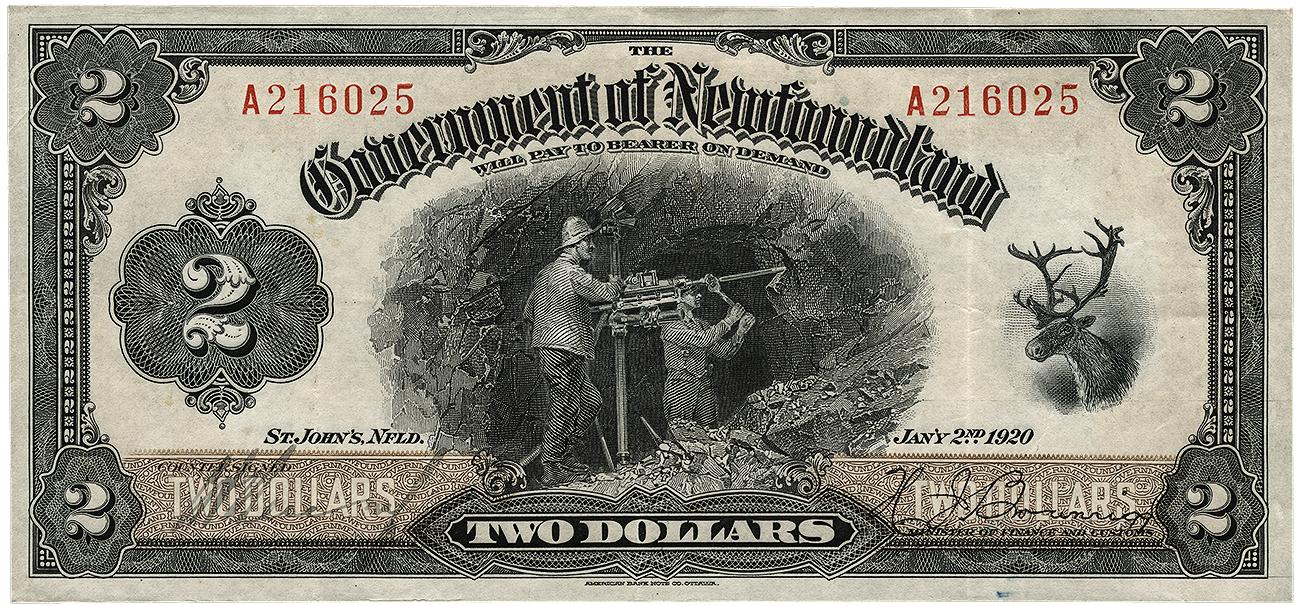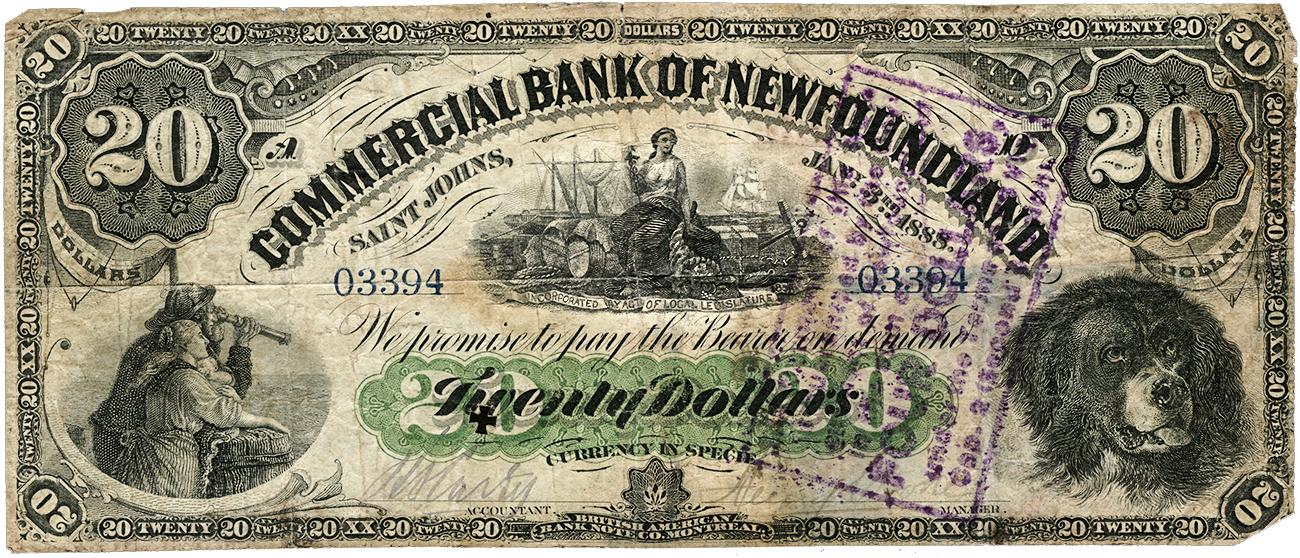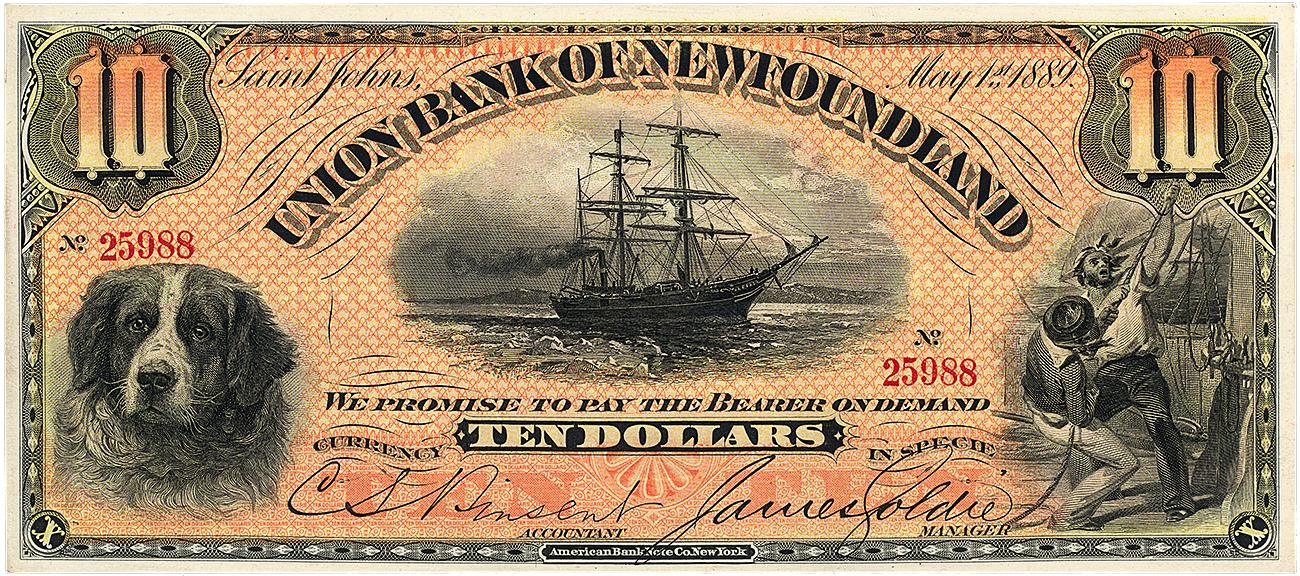
The Public Works department issued cash notes to pay for road construction and maintenance. The unusual denomination of 80 cents relates to the exchange rate between a British £1 gold sovereign and its Newfoundland currency equivalent of $4.80.
Source: Newfoundland, 80 cents, cash note, 1909 | NCC 1964.88.454

The last of Newfoundland’s paper money featured a mining scene: an industry in which the island had high hopes to put its economy back on the road to prosperity after the decline of the cod fishery.
Source: Newfoundland, 2 dollars, note, 1920 | NCC 1963.14.3
Financial panic and the fall of the Newfoundland banks
Newfoundland’s two banks, the Commercial and the Union, were the main providers of capital and currency for the colony. Yet by 1894, with a drying up of the cod fishery, difficulty in increasing mining output and rising costs to build the railway, the banks’ finances were stretched thin. They were overdrawn on their loans and riding the edge of insolvency. Acting on these rumours, people quickly sought to withdraw their money from the banks, only to learn that there were no funds to do so. Unable to meet their financial obligations, both banks permanently closed on December 10, 1894. The effects were immediate with businesses failing, workers losing their jobs and the price of food and other essentials rising. The entire colony was on the verge of bankruptcy. Payment of specie was suspended until Newfoundland passed legislation to wind up the affairs of the failed banks and for others, namely, the Bank of Montreal, the Bank of Nova Scotia and the Merchant’s Bank of Halifax (later, the Royal Bank of Canada), to come to the rescue. Notes of the Commercial and Union were redeemed at huge discounts. The inhabitants of Newfoundland who had faith in the banks to protect their savings lost almost everything.

The purple stamp on this note adjusted its value to $4 for redemption by the Newfoundland government after the Commercial Bank’s failure.
Source: Commercial Bank of Newfoundland, 20 dollars, note, 1888 | NCC 1989.29.8

The vignette of the loyal, stoic and alert Newfoundland dog on this Union Bank note could not protect the bank from imminent failure. It was a victim of the same financial troubles that afflicted the Commercial Bank.
Source: Union Bank of Newfoundland, 10 dollars, note, 1889 | NCC 1964.37.6
The 20th century and a new attitude toward Confederation
Newfoundland never fully recovered from the 1894 financial crisis. And over the decades that followed, the option of joining Confederation seemed more and more attractive. The problem was that the rest of the Dominion of Canada was less enthusiastic about accepting it and its economic troubles. Throughout the First World War and the Great Depression, Newfoundland’s financial situation was desperate—so much so that, in 1934, the British parliament suspended the Newfoundland government and appointed a commission of government in hopes of steering the colony toward recovery. The Second World War turned around the colony’s fortunes, with increased immigration and influxes of money for the war effort. Newfoundland was again on the road to economic and financial stability, right in time for talks on joining Confederation to resurface.
1949: Newfoundland finally joins Canada
In December 1945, the British parliament announced that Newfoundland would hold a National Convention to choose the colony’s political destiny: self-government or union with Canada. The factions were equally split, but the pro-Confederation delegates led by Joey Smallwood won the motion to go to Ottawa to discuss terms for joining with Canada. While several delegates of the National Convention rejected the draft terms, disagreeing over the style of government, active campaigning in favour of Confederation allowed for the option to remain on the referendum ballot. On June 3, 1948, Newfoundlanders went to the polls. In a low turnout, the votes were split, with no clear winner. The results of a second referendum held the following month gave Confederation the nod. The final Terms of Union were signed on December 11, 1948, and in February 1949, the Canadian Parliament ratified them. Newfoundland was in. Labrador was physically separated, but had always been a part of Newfoundland. To reflect this, the province changed its official name in 2001 to Newfoundland and Labrador, recognizing it as a single entity.




